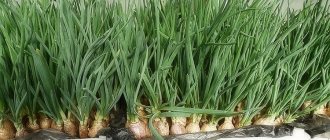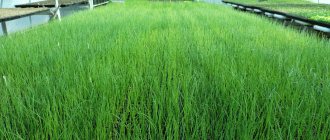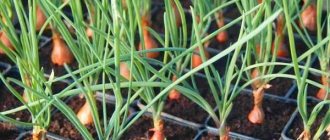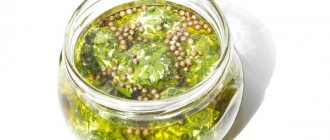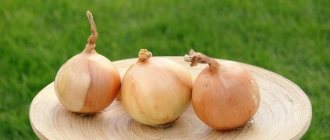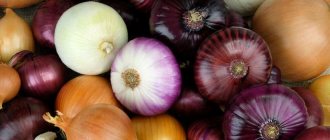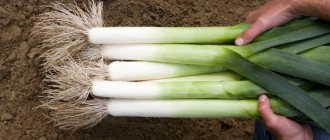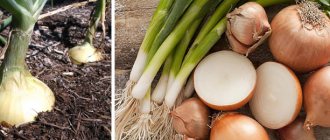There are several ways to grow onions: from seeds, small bulbs, and onion sets. If bulbs are planted on an open ridge and in a greenhouse in spring and summer, and in winter they are planted only in a heated room, then seeds are sown in the ground in late autumn, spring, summer, and in the cold season - in an apartment. The seed method takes a longer period of time, but allows you to grow perennial onions, so many people prefer it.
Onion seeds are stored for 3-4 years, but, regardless of the storage period, they need to be checked for germination so as not to be sown in vain. To do this, take ten seeds, wrap them in a damp cloth, put them in a bag and place them in a warm place. If six seeds have germinated, then the germination rate is 60% and you need to take a little more material; if all of them have germinated, then the germination rate is excellent.
Planting bulbs in the ground
Onions are very low maintenance. This also applies to growing conditions. But it should be remembered that the quality of planting material is the key to a future abundant harvest.
Optimal timing
On average, the greens of most varieties of onions ripen in 15–20 days. This is what we need to proceed from when determining the timing of its disembarkation.
At home, time doesn’t really matter; new bulbs are planted year-round, as needed. In greenhouses, planting is practiced in the cold season (October-April); in winter, the demand for fresh herbs is much higher.
In open ground, the specific period depends on the growing region. The soil at a depth of 4–5 cm should warm up to at least 6–8ºС. In temperate climates this is usually the first half of May. During the summer, the bulbs can be replanted 2-3 more times, timing the time so that you have time to cut the greens before the first frost.
If the crop is grown from seeds, as a biennial plant, they are sown in the garden bed in mid-summer. Fresh greens will appear literally from under the snow; they can be cut in April or early May.
Preparing the bed
Choose a place for the culture that is well lit by the sun and protected from the wind. In the shade, the feathers stretch out, thin out, and become unaesthetically pale. The substrate must be loose, well permeable to air and water. Good predecessors for onions are any Pumpkin and Nightshade, all types of cabbage.
During the digging process, the onion bed is cleared of weeds and all necessary fertilizers are applied.
In the fall, the soil is dug up, 3–4 liters of humus or rotted compost, 20–25 g of simple superphosphate or potassium sulfate and 10–15 g of any mineral nitrogen-containing fertilizer are added per 1 m².
Humus is a natural remedy for increasing soil fertility
2–3 days before planting, it is loosened shallowly, leveled and carefully compacted. The latter is necessary so that after planting the onions, the substrate does not sag excessively.
Preparation of planting material
The best choice in this case is bulbs about 3-4 cm in diameter weighing 10-15 g. They need to be cleaned of dried scales and sorted, rejecting all specimens with the slightest suspicious traces, reminiscent of mold or rot, dents, cracks. Approximately the same size is especially important when onions are planted on greens on an industrial scale - this subsequently ensures simultaneous cutting of the feather.
Bulbs for planting are selected very carefully - the future harvest depends on this
A mandatory step is disinfection. To disinfect, selected bulbs are immersed in a pale pink solution of potassium permanganate for several hours. Another option is salt water (a tablespoon per liter). You can add a few drops of any biostimulant to the solution (Epin, Heteroauxin, Kornevin, Immunocytophyte).
Potassium permanganate solution is one of the most common disinfectants
A common disease that can almost completely destroy a feather is peronosporosis. For prevention, planting material must be heated at a temperature of 40ºC for 7–8 hours.
To stimulate the bulbs to more actively form greenery, the top quarter is cut off, ensuring a greater supply of oxygen to the leaf embryos. To enhance the effect, 2–3 longitudinal cuts up to 1.5–2 mm deep are also made.
Cutting off the top of the onion will help you get greens faster.
For the same purpose, the onions are poured into a pile and watered with warm (30–35ºС) water. Then it is covered for 4–6 days with burlap or other material that allows air to pass through, but not light. The room temperature is maintained at a level not lower than 25ºС.
Recent Entries
Lilac perennials that are beautiful, compact and do not crowd out other plants Why when buying seedlings you should not take the sellers’ word for it and how to determine the age of the plant using 3 signs Tomato seedlings have turned purple or whitish: why the color has changed and how to save the plants
The described preparation methods shift the timing of cutting greenery back by 4–7 days and increase the yield of feathers by at least 60%.
Video: preparing bulbs and planting them in the ground
Different landing methods
There are two ways to plant onions:
- Tape. Planting in furrows is familiar to all gardeners. Between adjacent bulbs, depending on their size, leave 5–7 cm, the row spacing is 12–20 cm. After planting, the furrows are filled with soil.
Almost all gardeners practice planting onions using the strip method in their garden plots.
- Mostovoy. The bulbs are located on the surface of the bed as tightly as possible, end to end. The base is pressed slightly into the soil. They are covered with a layer of soil no more than 2–3 cm thick on top. This method is often practiced when planting onions on greens in greenhouses. The bulb itself has almost no opportunity to develop; all the nutrients it contains go to the feathers. Up to 10–12 kg of planting material is needed per 1 m².
Planting onions using the bridge method forcibly limits the development of the bulbs, forcing them to give up all their nutrients to the leaves
Onion seeds for greens are planted in furrows at intervals of 30–40 cm. They are sown very abundantly. Because of this, the seedlings are extremely dense. When the first leaves appear, they will need to be thinned out, creating intervals of 2-3 cm.
When growing feathers, planting seeds is extremely rare. Its only advantage is the low cost of planting material. You will have to wait a very long time for the harvest.
Obtaining greens from onion seeds is a fairly lengthy procedure.
Video: growing onions from seeds
Optimal planting dates
Planting onions before winter must be done at the right time so that the planting material can take root, but the seedlings do not have time to appear before the first frost.
Basic recommendations for choosing the timing of planting winter onions on greens are listed below:
- it is recommended to place planting material in the ground in the second half of October;
- planting is carried out approximately a month before the predicted first frost;
- the air temperature at the time of planting and for several days after it should be about +5°C;
- the temperature on the soil surface at the time of planting should be +3…+4°C.
Harvest and storage
Green onions are ready for cutting when the length of the feather reaches approximately 30 cm. You cannot delay harvesting - the feathers greatly lose their presentability (they shrivel, turn yellow), and their taste also suffers. As soon as they began to bend toward the ground, it was definitely time.
In order for the feathers to continue to grow, existing ones must be cut off above the shoot growth point. Use sharp scissors or a small pruner for this. Such tools cause minimal damage to the plant. At home, you can simply carefully pinch off individual feathers as needed, gradually moving from the periphery to the center.
If you leave the harvest of green onions in the garden too long, its quality will deteriorate sharply.
You can keep the feather fresh for 2-3 weeks by placing it in the refrigerator. There is no need to wash it beforehand. There are alternative storage methods:
- In glass jars. Place small dry feathers in a jar and close it tightly with a lid. If they are not broken or bent in the process, the greens will remain fresh for about a month. The container should be placed in a cool, dark place. By filling the onions with vegetable oil, you will extend the shelf life by another 4-6 weeks, but in this form it is not suitable for all dishes.
- In a plastic bag. Unwashed feathers are placed in a bag of a suitable size, tied, and several holes are made with a knife or fork for ventilation. Keep the package in the cellar or basement.
- In thick paper or linen napkin. It is strictly forbidden to use newspapers - printing ink contains lead. The feather is washed, the water is allowed to drain, wrapped in paper or cloth, and lightly sprayed on top with a spray bottle. The package is wrapped in cellophane and put away in a cellar or pantry.
In the refrigerator, onions are stored in a special compartment for vegetables and fruits.
Dried and frozen onions are stored the longest without losing their beneficial properties (two years and a year, respectively). You can dry it either naturally or in an oven or a special dryer. To freeze the feathers, you must first finely chop them. The onions are also salted and fermented.
Before freezing, chop the green onions - this way they take up less space
Methods for growing onions
Cultivation in open ground is not the only method of growing onions. Professional farmers plant it in greenhouses. There is nothing difficult about getting fresh herbs at home.
In the greenhouse
The main criterion for choosing a variety in this case is productivity. To obtain a large mass of greenery in a greenhouse, you need fertile soil. Its surface is sprinkled with dolomite flour or slaked lime - this will prevent mold from developing.
In greenhouses without heating, the bulbs are planted using the bridge method at the very end of autumn, sprinkled with a mixture of humus and peat chips (a layer at least 5–6 cm thick). The mulch is removed in the last ten days of February. The onions are watered with warm water, the beds are covered with plastic film until shoots appear.
In heated greenhouses, it is easier to maintain optimal conditions for forcing feathers - onions need a temperature of 17–20ºС during the day and 13–15ºС at night with a 12-hour daylight hours. When the first shoots appear, the daytime temperature is raised to 21–23ºС, but no more. A feather grows faster in warmth, but stretches greatly.
Growing green onions in a greenhouse is economically justified only on an industrial scale
Ventilation is added to the usual measures for caring for crops in a greenhouse. Special mineral complexes for onions are used as fertilizing. Watering is completely stopped 4-5 days before the planned cutting of greenery.
Video: onions for greens in a greenhouse
On hydroponics
The method is very popular among those who grow herbs for sale; hydroponics allows you to get feathers all year round and save space. The slabs are placed on racks in 3–4 tiers.
The bulbs are planted in special mineral wool slabs or mats, pre-moistened and spilled with a fertilizer solution. The interval between them is about 2 cm, the width of the rows is 3 cm. They are covered with a layer of perlite or vermiculite 2–3 cm thick on top.
When growing green onions hydroponically, it is necessary to provide them with optimal or close to optimal conditions.
Over the next week, the plantings need shade and coolness. As soon as developed roots appear, daylight hours are increased to 12–14 hours, and the temperature is raised to 23–25ºС. Feathers reach a length of 25–30 cm after 12–15 days. Always make sure that the “substrate” remains slightly moist at all times, water it with a fertilizer solution.
Video: green onions in hydroponics
At home
The technology is more or less familiar to everyone. The bulb is placed upside down in a glass of water or planted in a container with a diameter of 7–10 cm. Any universal substrate for seedlings is suitable. You can also use a deep tray to increase the yield. Before emergence, the bulbs are provided with heat (25–30ºС). As soon as the feathers grow to 1.5–2 cm in length, the temperature will need to be lowered to 20–23ºС.
Growing onions in one container is more convenient than in several separate jars
The water in the container is changed every 2-3 days, the substrate is watered twice a week. It is not necessary to apply fertilizing. All the necessary feathers will be obtained from the bulb itself; after cutting off the greens, they simply throw it away. The wait for the harvest is not long - the first feathers appear in a week or even earlier, they reach the required length in 8-12 days. Containers should be kept away from radiators and other heating devices. Otherwise, the soil quickly overheats and feathers grow poorly.
If onions are grown in water at home, make sure that the bottom does not touch its surface, otherwise rot will quickly develop.
You can save space by growing green onions in bottles with the neck cut off. Several 5–8 holes are cut out in the walls of a 5-liter container, matching the diameter of the bulbs. They are inserted inside, soil is poured into the bottle, compacting well. Water the plantings by dipping the container into water.
Onions grow well at home and in sawdust; they retain moisture for a long time, allowing you to get by with 1-2 waterings. Just before planting, they must be doused with boiling water or soaked for several hours in a solution of potassium permanganate for disinfection. Sawdust is used only once: after harvesting, the substrate is completely changed.
Video: growing onions on a windowsill
Care
- After germination, fertilize the bed with urea or superphosphate (up to 40 g/m2);
- When forming the bulbs, add potassium chloride (10 g/m2);
- In hot, dry weather, water onions twice a week. If spring onions are grown for feather use, then watering should, on the contrary, be plentiful;
- Weed weeds periodically;
- Loosen the soil when a crust forms on the surface of the earth to ensure ventilation of the bulbs;
- If the feathers turn yellow, stop watering and after 7-10 days you can dig up the onions.
note
If the onion is not dug up in time, its growth will resume, and the bulbs cannot be stored for a long time.
You should dig carefully, trying not to damage the bulbs.
If the care and planting conditions are not followed, the following may occur:
- Due to too deep planting, the seedlings may not have enough strength to germinate, and due to shallow planting, the sets or seeds may freeze;
- Freezing in the absence or insufficient mulching.
- Bulb rotting due to excessive waterlogging;
Thus, by choosing the right variety, timing and planting method, you can get an early onion harvest without unnecessary hassle.

